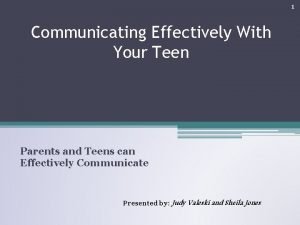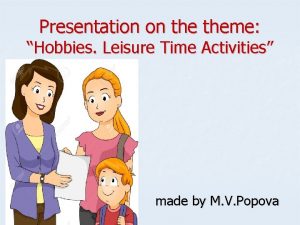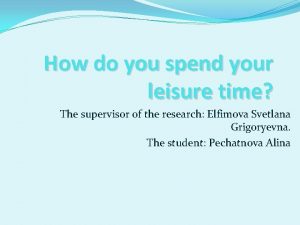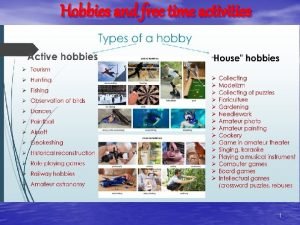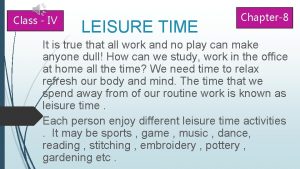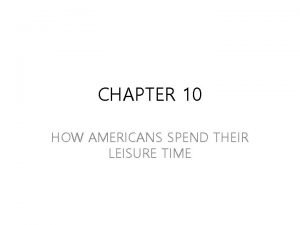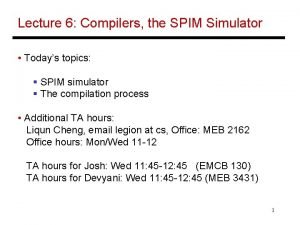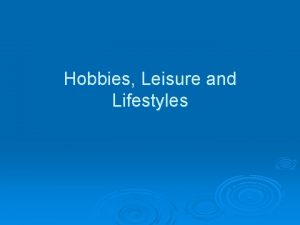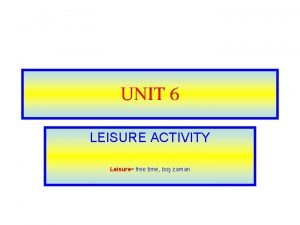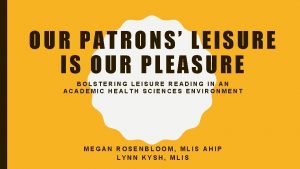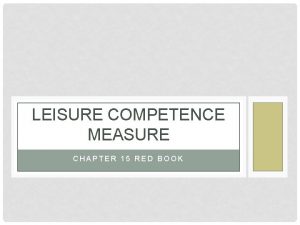Todays Typical Teenager Spends more time in leisure








































- Slides: 40

Today’s Typical Teenager • Spends more time in leisure activities than in “productive” activities • Spends more time alone than with family members, prefers to be with friends • Spends four times as many hours per week at part-time jobs as spent on homework

Adolescents’ Free Time in Contemporary Society • Post–World War II affluence led to more free time for adolescents – Targeted as consumers by marketing industry – Leisure expenditures (movies or eating out) • American adolescents spend more time on leisure, less time being productive than other countries – American students spend < 5 hours per week on homework – In Asian countries– 4 to 5 hours per day on homework

The Emergence of the Student-Worker • Before 1925 most entered the workforce by 15 years of age • Adolescents were either students or workers, not both • Proportion of high school students with part-time jobs rose dramatically between 1940 and 1980 • New jobs were created in retail trade and services (for low wages, short shifts)

The Adolescent Workplace • Most American girls babysit as their first job • American boys usually do yard work as their first work experience • For older adolescents the majority of work is in restaurants or retail sales

Sex Differences in the Adolescent Workplace

Characteristics of Teen Jobs • On average high school: – Sophomores work 15 hours a week – Seniors work 20 hours per week • Little or no contact with adults – Other workers are teenagers too – Supervisor typically not much older than adolescent – Many customers are teenagers too • Few permit independent behavior or decision making – Little instruction is received from supervisors – Skills learned in school rarely used at work – Jobs often are repetitive or boring, sometimes stressful, leading to injury and accidents

Working and Adolescent Development • Most people believe that working helps teens build character, teaches them about the real world, and prepares them for adulthood • Recent studies show that benefits of working during adolescence have been overstated – Premature affluence – Working more than 20 hours/week may jeopardize school performance: (absent more often, less involvement in extracurriculars, report enjoying school less, spending less time on homework, earning lower grades)

Working and Adolescent Development • Work and Problem Behavior – Thought that working would deter teens from criminal activity by keeping them out of trouble – Working long hours may actually be associated with increases in aggression, school misconduct, precocious sexual activity, minor delinquency • Differential Impact of Work • Middle class–working associated with problem behaviors • Poor youth–working may not lead to problem behavior

Problem Behavior and Work • Adolescents who work are more likely to: – Use alcohol – Smoke cigarettes – Use drugs It is important to note: CORRELATION DOES NOT ASSUME CAUSATION! Scholars disagree on whether working leads to greater substance use or whether this means that adolescents who work already have a tendency toward substance use.

Occupational Deviance Over 60% of working adolescents had engaged in at least one type of occupational deviance after being employed for 9 months

Perceived Effects of Adolescent Work Percentage of Adolescents Indicating Benefits Girls Boys Responsibility 90. 2 80. 3 Money Management 65. 7 57. 4 Learned Social Skills 87. 7 78. 3 Work Experience Skill Development 43. 4 42. 1 Work Ethic 73. 3 68. 1 Independence 75. 0 77. 7 Time Management 78. 6 74. 5 Learned about life/ Shaped future 26. 2 29. 0

Work and Psychological Functioning • Up to 10 hours per week – Not related to any psychological symptoms – Little effect on adolescent development • Beyond 10 hours per week – – Anxiety Depression Sleep per night declines Disruptive to eating and exercise habits • Beyond 20 hours per week – Problems become considerably worse

Grade-Point Averages

Relation Between Work Hours & School Performance Beyond 10 hrs/week, the more adolescents work, the poorer their school performance.

The Adolescent Consumer • In 2001, teenagers spent $172 billion of their own money, and influenced billions in household spending • Virtually all of a teen’s money is spent on purchases related to leisure activities – Girls spend money on clothes, food, and cosmetics, in that order – Boys use their money for food, clothes, and saving for big-ticket items • Viral marketing – Uses Internet sites such as My. Space and Facebook to target thousands of teens because of their influence over friends’ purchasing habits

Percentage of Adolescents Watching from One to Six or More Hours of Television a Day Hours per Day 8 th Grade 12 th Grade 6 or more 14% 7% 4 to 5 27 18 2 to 3 45 46 1 or fewer 14 29

Adolescents and Leisure

Adolescents’ Free Time and Their Moods • Distinction between “Leisure” and other activities – Leisure activities: chosen by teens – Time at school and work: chosen by others • Experience Sampling Method • Adolescents’ state of mind is more positive in structured leisure than when in classes or with friends

Structured Leisure Activities • Two-thirds of American high school students are in one or more extracurricular activities • Athletics most popular in the United States • Other popular activities – Music (band, chorus, orchestra, glee club) – Academic (science club, language clubs)

Participation in extracurricular activities benefits less competent students more than their academically talented counterparts

Unstructured Leisure Time • Eight million U. S. school-aged youngsters are not supervised by parents after school. • More arrests occur in school day afternoons • Most studies show that latchkey children are not different from their peers in psychological development, school achievement or self-conceptions

Leisure and the Mass Media • • • Availability of media in young people’s homes is greater than previously thought Many adolescents view TV, listen to music, or play video games, all in their bedrooms The average adolescent spends nearly 7 hours each day using one or more forms of media

Adolescents have access to a range of media in their own bedrooms

Media Preferences by Age Group

Media & other Socialization Sources • Media is market-driven – providers will provide adolescents with what they believe adolescents want § § Great diversity of media available Media socialization “goes over the heads” of other socializing adults It is important to note: Not all of the media used by adolescents are contrary to the aims and principles of adult society – much of it in fact, is quite conservative. What media reinforces conventional values?

Television and Aggressiveness • Great deal of research attention focused on the extent to which television provokes violence in young people • Majority of violent crimes committed by males aged 15 -25 • 1960 -1990 saw a rise in both violent crime and violent television programming • Most of the research on the issue is correlational (can’t prove causation!) • Many field studies have been conducted to address the question: Does watching violence on TV cause adolescents to become more aggressive, or are adolescents who are more aggressive simply more likely to enjoy watching violence on TV?

Computer Games & Aggressiveness • A majority of adolescents’ favorite games involve themes of violence • Studies have shown that playing violent computer games is related to heightened aggressiveness, hostility and anxiety Do you play computer games? Which one (s)? Does it contain violent themes?

Leisure and the Mass Media • Research shows that – Exposure to violent television does lead to more aggressive behavior – Exposure to images of sex does in fact affect adolescents’ attitudes about sex – Exposure to images of drug and alcohol use does affect adolescents’ beliefs about these matters

Sexual Portrayals on TV Males • Preoccupied with sex • Always “ready and willing” • Recreational attitude toward sex Females • Value men mainly for physical appearance, wealth and status • Recreational attitude toward sex Research Summary (Cope-Farrar & Kunkel, 2002) • 82% of programs had sexual content • Sexual behavior more frequent than sexual talk • Sexual behavior between partners with established relationship (not married) • Kisses and hugs; Intercourse or nudity infrequent • Discussion of sexual risk RARELY took place

Music TV: Basics • MTV started in USA 1981 – now broadcast worldwide. A global force • American adolescents watch MTV approx. 15 -30 minutes a day Two categories: • Performance Videos – just like a concert conveying the song • • Concept Videos – tell a story, like a mini-movie that enacts the lyrics of the song About 15% of videos contain violence (usually mild vs. severe violence) About 75% contain sexual themes (implied vs. explicit)

Controversial Music: Rap • “Rap is Black America’s TV station. It gives a whole perspective of what exists and what Black life is about” (Decker, 1994, p. 103) • Reggaeton



Leisure and the Mass Media • Research shows that exposure to images of drug and alcohol use does affect adolescents’ beliefs about these matters

Big Tobacco & Advertising • Cigarettes are the second most heavily promoted consumer product in the USA, totaling Six billion dollars per year • Is it targeted to adolescents? • 90% of smokers start by age 18 • Ads present images of fun, independence, and “coolness” • According to research, the effects of advertising on brand choice was three times as strong for adolescents as adults • The three most popular brands are the most heavily promoted

Adolescents’ Responses: Cigarette Ads See the pattern? ?

Internet Uses by 12 -15 year olds Searching for information for school projects Favor chat rooms on relationships and lifestyle Or with friends on instant messaging Boys more likely to play computer games & download music Girls more likely to visit chat rooms and email

What a Tangled Web…. Internet Benefits • Access to information – potential to enhance education • Can be a source of positive social interactions – opportunities to practice communication and engage in “identity play, ” and finding answers to problems they may be facing Internet Cautions • Chat rooms sometimes frequented by sexual predators seeking to victimize children and adolescents • Academic cheating via downloading or purchasing prewritten papers • Promote social isolation (displacement effect) • Cyber-Bullying

Leisure and Sex-Role Socialization • Sociologist Donna Eder’s study on sex -role socialization in high school extracurricular activities – Athletics is the chief route to status for boys (emphasizes toughness, dominance, and competition) – Cheerleading is chief route to status for girls (emphasizes good grooming, appearance, “sparkle”) • Magazines aimed at girls focus on appearance, dating, being thin

Magazine Ads: Getting a Man
 Lirik lagu more more more we praise you
Lirik lagu more more more we praise you More more more i want more more more more we praise you
More more more i want more more more more we praise you Love language touch
Love language touch Teenager nn
Teenager nn To english
To english Short term goals for teenager
Short term goals for teenager Unhealthy lifestyle essay
Unhealthy lifestyle essay Effective communication with your teenager
Effective communication with your teenager Lack of understanding in relationship
Lack of understanding in relationship Wood wood teenager
Wood wood teenager Thais plaza
Thais plaza Leisure time presentation
Leisure time presentation What is leisure
What is leisure Speaking questions about hobbies
Speaking questions about hobbies Leisure time hobbies
Leisure time hobbies Leisure time class 4
Leisure time class 4 Growth of leisure time apush
Growth of leisure time apush How american spend their leisure time
How american spend their leisure time Unit 2 leisure time
Unit 2 leisure time Trevor spends 45 minutes a day in front of an intense light
Trevor spends 45 minutes a day in front of an intense light He spends little money
He spends little money Example of elapsed time
Example of elapsed time The more you take the more you leave behind
The more you take the more you leave behind The more you study the more you learn
The more you study the more you learn Aspire not to have more but to be more
Aspire not to have more but to be more Law of inertia meaning and example
Law of inertia meaning and example Knowing more remembering more
Knowing more remembering more More love to thee o lord
More love to thee o lord More choices more chances
More choices more chances Human history becomes more and more a race
Human history becomes more and more a race Generations
Generations Are you going to class today
Are you going to class today Todays with apostrophe
Todays with apostrophe Todays worldld
Todays worldld Define radient energy
Define radient energy Todays globl
Todays globl Todays wordlw
Todays wordlw Chapter 13 marketing in todays world
Chapter 13 marketing in todays world Todays plan
Todays plan Todays sabbath lesson
Todays sabbath lesson Welcome for sabbath school
Welcome for sabbath school







